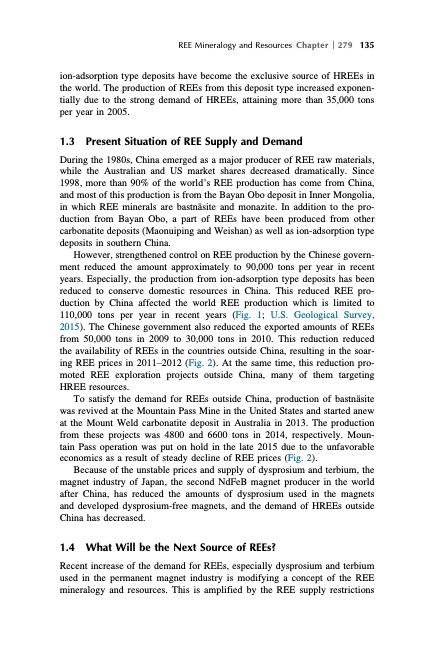
PDF Publication Title:
Text from PDF Page: 171
REE Mineralogy and Resources Chapter 279 135 ion-adsorption type deposits have become the exclusive source of HREEs in the world. The production of REEs from this deposit type increased exponen- tially due to the strong demand of HREEs, attaining more than 35,000 tons per year in 2005. 1.3 Present Situation of REE Supply and Demand During the 1980s, China emerged as a major producer of REE raw materials, while the Australian and US market shares decreased dramatically. Since 1998, more than 90% of the world’s REE production has come from China, and most of this production is from the Bayan Obo deposit in Inner Mongolia, in which REE minerals are bastnäsite and monazite. In addition to the pro- duction from Bayan Obo, a part of REEs have been produced from other carbonatite deposits (Maonuiping and Weishan) as well as ion-adsorption type deposits in southern China. However, strengthened control on REE production by the Chinese govern- ment reduced the amount approximately to 90,000 tons per year in recent years. Especially, the production from ion-adsorption type deposits has been reduced to conserve domestic resources in China. This reduced REE pro- duction by China affected the world REE production which is limited to 110,000 tons per year in recent years (Fig. 1; U.S. Geological Survey, 2015). The Chinese government also reduced the exported amounts of REEs from 50,000 tons in 2009 to 30,000 tons in 2010. This reduction reduced the availability of REEs in the countries outside China, resulting in the soar- ing REE prices in 2011–2012 (Fig. 2). At the same time, this reduction pro- moted REE exploration projects outside China, many of them targeting HREE resources. To satisfy the demand for REEs outside China, production of bastnäsite was revived at the Mountain Pass Mine in the United States and started anew at the Mount Weld carbonatite deposit in Australia in 2013. The production from these projects was 4800 and 6600 tons in 2014, respectively. Moun- tain Pass operation was put on hold in the late 2015 due to the unfavorable economics as a result of steady decline of REE prices (Fig. 2). Because of the unstable prices and supply of dysprosium and terbium, the magnet industry of Japan, the second NdFeB magnet producer in the world after China, has reduced the amounts of dysprosium used in the magnets and developed dysprosium-free magnets, and the demand of HREEs outside China has decreased. 1.4 What Will be the Next Source of REEs? Recent increase of the demand for REEs, especially dysprosium and terbium used in the permanent magnet industry is modifying a concept of the REE mineralogy and resources. This is amplified by the REE supply restrictionsPDF Image | HANDBOOK ON THE PHYSICS AND CHEMISTRY OF RARE EARTHS

PDF Search Title:
HANDBOOK ON THE PHYSICS AND CHEMISTRY OF RARE EARTHSOriginal File Name Searched:
Chemistry-Rare-Earths-49.pdfDIY PDF Search: Google It | Yahoo | Bing
Sulfur Deposition on Carbon Nanofibers using Supercritical CO2 Sulfur Deposition on Carbon Nanofibers using Supercritical CO2. Gamma sulfur also known as mother of pearl sulfur and nacreous sulfur... More Info
CO2 Organic Rankine Cycle Experimenter Platform The supercritical CO2 phase change system is both a heat pump and organic rankine cycle which can be used for those purposes and as a supercritical extractor for advanced subcritical and supercritical extraction technology. Uses include producing nanoparticles, precious metal CO2 extraction, lithium battery recycling, and other applications... More Info
| CONTACT TEL: 608-238-6001 Email: greg@infinityturbine.com | RSS | AMP |